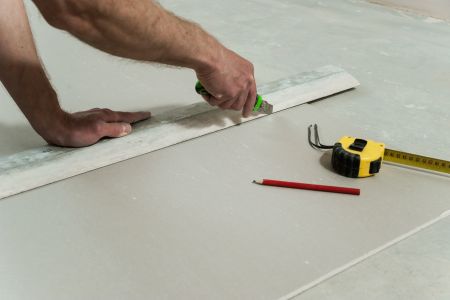Sheetrock Repair Tips and Tricks

Sheetrock, also known as drywall, is a popular material used in modern construction due to its versatility and ease of installation. However, like any other building material, sheetrock can suffer from damage over time. From minor dents and holes to major cracks and water damage, addressing these issues promptly can prevent further deterioration and maintain the integrity of your walls. In this guide, we'll explore common types of sheetrock damage and provide sheetrock repair tips and techniques for effective remedies.
Common Types of Sheetrock Damage
- Nail Pops: These occur when nails or screws push through the drywall surface, creating a small, raised bump.
- Small Holes: Often caused by doorknobs, picture hangers, or accidental impacts, small holes are typically less than an inch in diameter.
- Cracks: Cracks can form due to settling of the building, temperature changes, or improper installation.
- Large Holes: Larger holes, usually more than an inch in diameter, can result from accidents or the removal of fixtures.
- Water Damage: Water damage often leads to staining, warping, and mold growth, requiring more extensive repairs.
Tools and Materials Needed
- Utility knife
- Drywall saw
- Putty knife
- Drywall tape
- Joint compound (spackle)
- Sanding sponge or sandpaper
- Drywall patch (for large holes)
- Primer and paint
Steps for Repairing Sheetrock
Nail Pops:
- Use a utility knife to remove the raised portion around the nail or screw.
- Drive a new screw or nail into the wall about 1-2 inches above or below the original one.
- Apply joint compound over the area, smooth it out, and sand once dry. Prime and paint to finish.
Small Holes:
- Clean the hole and surrounding area.
- Apply a small amount of joint compound using a putty knife, pressing it into the hole.
- Smooth the surface, let it dry, and sand lightly. Repeat if necessary, then prime and paint.
Cracks:
- Use a utility knife to widen the crack slightly and remove any loose debris.
- Apply a strip of drywall tape over the crack edges. Allow it to dry, sand smooth, and apply additional coats if needed.
- Prime and paint the repaired area.
Large Holes:
- Cut out the damaged area using a drywall saw, creating a clean, square opening.
- Cut a drywall patch to fit the hole and secure it in place with screws.
- Apply drywall tape over the seams.
- Cover the patch and tape with joint compound, smoothing it out. Once dry, sand the surface, apply additional coats if needed, then prime and paint.
Water Damage:
- Identify and fix the source of the water leak to prevent future damage.
- Cut out the damaged drywall and replace it with a new piece.
- Tape and mud the seams, sand smooth, and apply primer and paint.
Prevention Tips
- Regular Inspection: Have a professional painter check your walls periodically for signs of damage or wear.
- Control Humidity: Use dehumidifiers and ensure proper ventilation to prevent moisture buildup.
- Gentle Handling: Avoid rough impacts and handle fixtures and wall hangings carefully.
Proper sheetrock repair not only restores the appearance of your walls but also maintains the structural integrity of your home. While minor repairs can often be tackled with DIY methods, larger or more complex issues may require assistance from a professional painter. At Johnson Painting LLC, we know all the tips and tricks and offer expert sheetrock repair services to ensure your walls look as good as new. Contact us today at 228-243-4312 for reliable and efficient repair solutions tailored to your needs.
We Get the Job Done Right! Contact Our Mobile Painters Today!